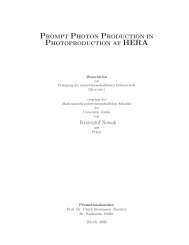Master Thesis Effect of vortex shaking on the ... - Physik-Institut
Master Thesis Effect of vortex shaking on the ... - Physik-Institut
Master Thesis Effect of vortex shaking on the ... - Physik-Institut
Create successful ePaper yourself
Turn your PDF publications into a flip-book with our unique Google optimized e-Paper software.
4 Interpretati<strong>on</strong> and C<strong>on</strong>clusi<strong>on</strong><br />
4.1 NdBa 2 Cu 3 O 7−d<br />
As discussed earlier, no melting transiti<strong>on</strong> could be found in NdBCO, i.e. we<br />
could not distinguish between measurements with or without <str<strong>on</strong>g>shaking</str<strong>on</strong>g>. Of<br />
course, this can be due to many very different reas<strong>on</strong>s. The most obvious<br />
would be that <strong>the</strong> <str<strong>on</strong>g>shaking</str<strong>on</strong>g> itself did not work, due to a malfuncti<strong>on</strong>ing coil<br />
or inadequate <str<strong>on</strong>g>shaking</str<strong>on</strong>g> parameters. But as far as I can say, <strong>the</strong> coil was<br />
working fine. There was definitely an ac current flowing in it, as <strong>the</strong> str<strong>on</strong>g<br />
Lorentz force it experienced and <strong>the</strong> resistivity measurements that were d<strong>on</strong>e<br />
automatically <strong>on</strong> <strong>the</strong> coil have proved. There is no reas<strong>on</strong> why <strong>the</strong> coil should<br />
not have induced a magnetic field and indeed a tiny difference between each<br />
<str<strong>on</strong>g>of</str<strong>on</strong>g> <strong>the</strong> separate runs could actually be seen, as menti<strong>on</strong>ed in <strong>the</strong> first part <str<strong>on</strong>g>of</str<strong>on</strong>g><br />
3.4, but <str<strong>on</strong>g>of</str<strong>on</strong>g> course it was not nearly <str<strong>on</strong>g>of</str<strong>on</strong>g> <strong>the</strong> magnitude we expected. This brings<br />
us to <strong>the</strong> <str<strong>on</strong>g>shaking</str<strong>on</strong>g> parameters. Within <strong>the</strong> limits <str<strong>on</strong>g>of</str<strong>on</strong>g> our technical possibilities<br />
I tried every reas<strong>on</strong>able combinati<strong>on</strong> <str<strong>on</strong>g>of</str<strong>on</strong>g> applied current (i.e. field strength),<br />
frequency and <str<strong>on</strong>g>shaking</str<strong>on</strong>g> time (i.e. number <str<strong>on</strong>g>of</str<strong>on</strong>g> <str<strong>on</strong>g>vortex</str<strong>on</strong>g> “steps”), but not <strong>on</strong>e <str<strong>on</strong>g>of</str<strong>on</strong>g><br />
<strong>the</strong>m was successful. Additi<strong>on</strong>ally <strong>on</strong>e can add that <strong>the</strong> used parameters had<br />
already been proved to be working by Willemin et al. in <strong>the</strong>ir experiments.<br />
I c<strong>on</strong>clude that <strong>the</strong> <str<strong>on</strong>g>shaking</str<strong>on</strong>g> was working properly and <strong>the</strong> reas<strong>on</strong> that no<br />
difference in resistance showed up has to be elsewhere. A. K. Pradhan et al.<br />
report in <strong>the</strong>ir 1999 paper [28] that <strong>the</strong>y encountered a str<strong>on</strong>g dependence <str<strong>on</strong>g>of</str<strong>on</strong>g><br />
<strong>the</strong> transiti<strong>on</strong> <strong>on</strong> <strong>the</strong> oxygen partial pressure during <strong>the</strong> growth <str<strong>on</strong>g>of</str<strong>on</strong>g> <strong>the</strong> crystal.<br />
They measured “a smeared first-order melting transiti<strong>on</strong> (FOT) for 0.01 and<br />
a distinct FOT for 0.03% and 0.05%, and a c<strong>on</strong>tinuous transiti<strong>on</strong> for 0.07%<br />
[O 2 partial pressure to Ar atmosphere during growth]”. It is not known to me<br />
in what percentage <str<strong>on</strong>g>of</str<strong>on</strong>g> O 2 our crystal was grown. Additi<strong>on</strong>ally, as menti<strong>on</strong>ed<br />
in sub-chapter 3.2, we treated it with a 1% Bromine-Methanol soluti<strong>on</strong> and<br />
had it in an oven under oxygen atmosphere to improve its surface, so it is quite<br />
possible that <strong>the</strong> crystals surface was under c<strong>on</strong>diti<strong>on</strong>s similar to <strong>the</strong> crystals<br />
<str<strong>on</strong>g>of</str<strong>on</strong>g> Pradhan with 0.07% O 2 partial pressure, which means that <strong>the</strong> transiti<strong>on</strong><br />
<str<strong>on</strong>g>of</str<strong>on</strong>g> our crystal was not distinct as expected, but instead actually genuinely<br />
c<strong>on</strong>tinuous and <strong>the</strong> <str<strong>on</strong>g>vortex</str<strong>on</strong>g> <str<strong>on</strong>g>shaking</str<strong>on</strong>g> could not have had an effect. As <strong>the</strong><br />
magnitude <str<strong>on</strong>g>of</str<strong>on</strong>g> disorder <str<strong>on</strong>g>of</str<strong>on</strong>g> both crystals, <strong>the</strong> NdBCO and <strong>the</strong> LuNiBC, was as<br />
well not known, it is also possible, that <strong>the</strong> pinning forces in <strong>the</strong> crystals were<br />
too str<strong>on</strong>g for any kind <str<strong>on</strong>g>of</str<strong>on</strong>g> <str<strong>on</strong>g>vortex</str<strong>on</strong>g> <str<strong>on</strong>g>shaking</str<strong>on</strong>g>, as <str<strong>on</strong>g>vortex</str<strong>on</strong>g> <str<strong>on</strong>g>shaking</str<strong>on</strong>g> is normally <strong>on</strong>ly<br />
used in just slightly disordered crystals, where <strong>the</strong> vortices are not far away<br />
from equilibrium. The most fundamental questi<strong>on</strong> is at last, if <str<strong>on</strong>g>vortex</str<strong>on</strong>g> <str<strong>on</strong>g>shaking</str<strong>on</strong>g><br />
influences resistivity measurements at all, this questi<strong>on</strong> arises because <str<strong>on</strong>g>of</str<strong>on</strong>g> <strong>the</strong><br />
fact, that resistivity measurements need a current, which does naturally not<br />
27
















